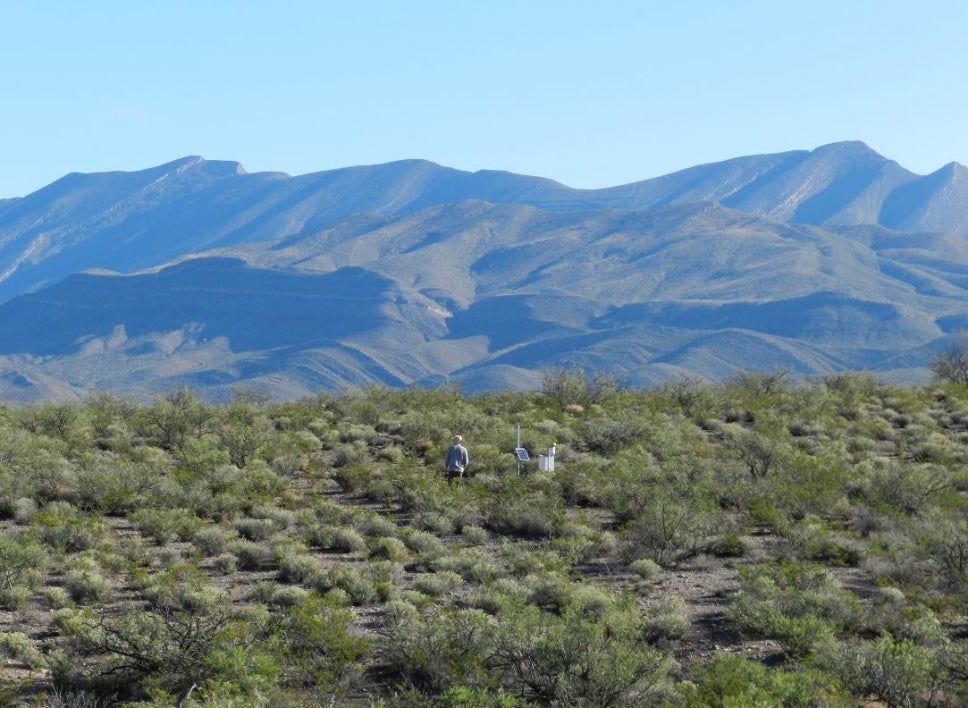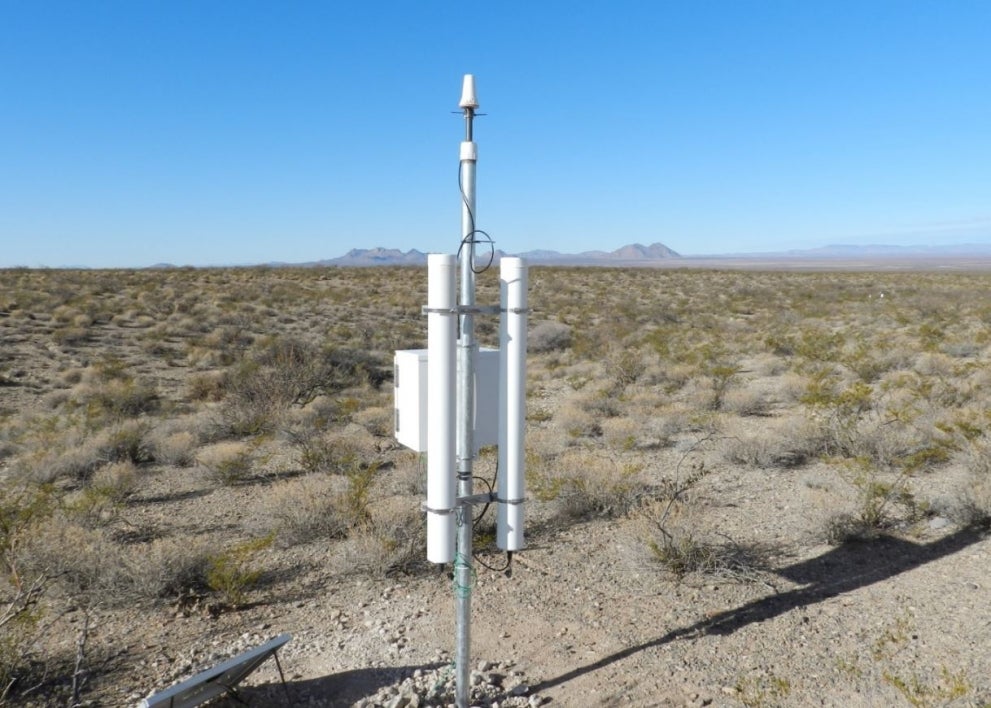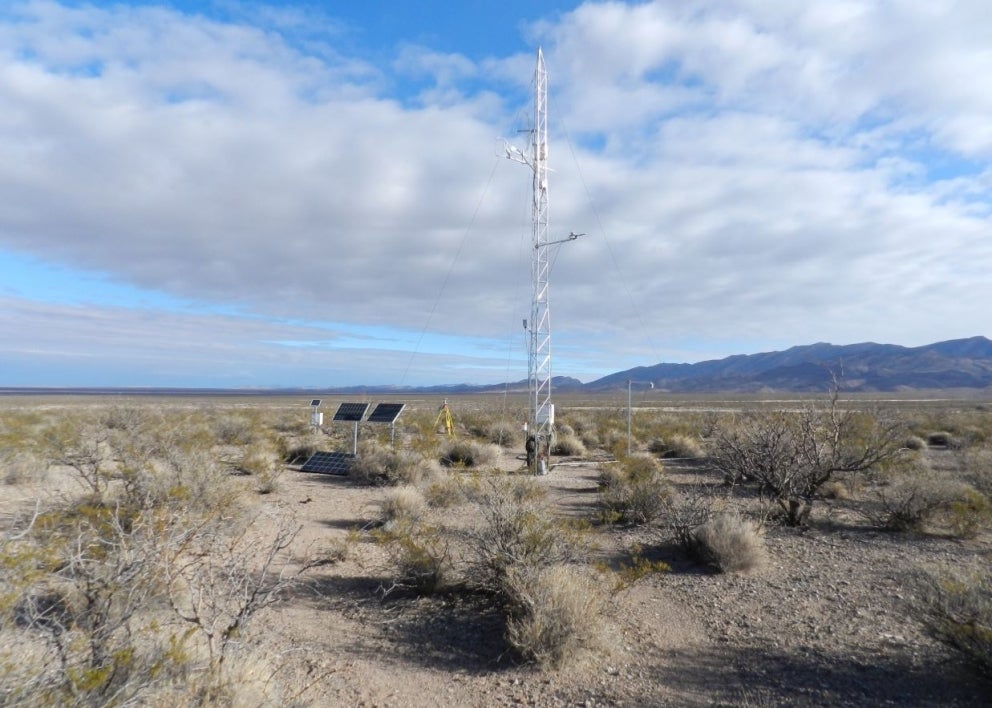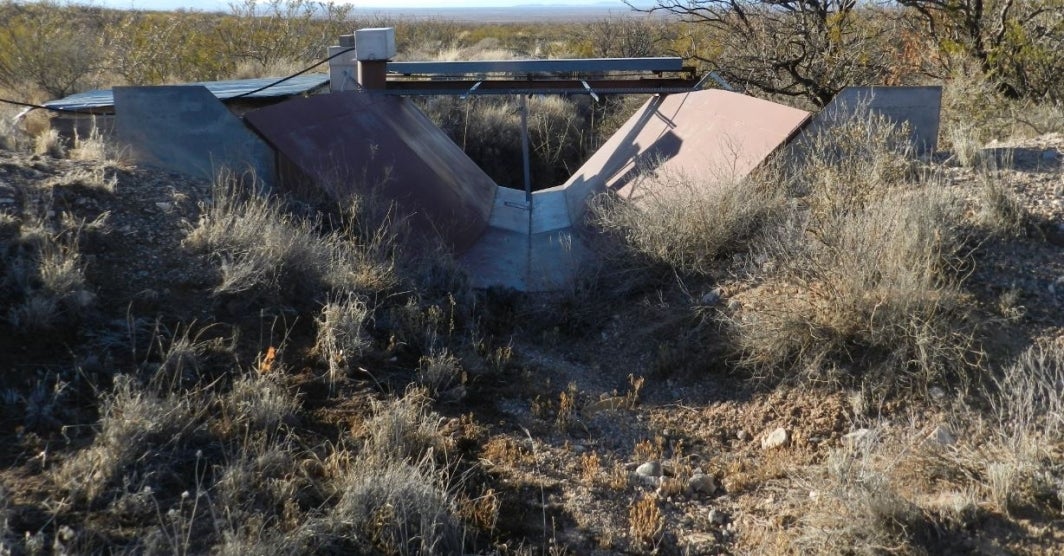Vegetation shifts can outweigh climate change in desert rangelands

The launch catapult for the fixed-wing unmanned aerial vehicle (UAV) used to observe the research site. Credit: Schreiner-McGraw/UCR
Grasslands across the globe, which support the majority of the world’s grazing animals, have been transitioning to shrub lands in a process that scientists call “woody plant encroachment.”
Managed grazing of drylands is the most extensive form of land use on the planet, which has led to widespread efforts to reverse this trend and restore grass cover.
Until now, researchers have thought that because woody plants like trees and shrubs have deeper roots than grass, woody plant encroachment resulted in less water entering streams and groundwater aquifers. This was because scientists typically studied the effect the grassland shift toward shrubs has on water resources on flat ground.
A new study from a team of researchers from ASU, the University of California, Riverside and the U.S. Department of Agriculture modeled shrub encroachment on a sloping landscape and reached a startling conclusion: Shrub encroachment on slopes can increase the amount of water that goes into groundwater storage. The effect of shrubs is so powerful that it even counterbalances the lower annual rainfall amounts expected as climate change continues.
“We were surprised to find that a transition from grassland to shrub land can increase sustainability of groundwater aquifers,” said lead author Adam Schreiner-McGraw, who recently earned his doctoral degree at ASU in the School of Earth and Space Exploration and is now a postdoctoral hydrology researcher at the University of California, Riverside. “The best way to increase focused recharge in this system is to increase the amount of runoff from hillslopes that gets concentrated in the streambeds.”
The intrusion of shrubs into grasslands is often considered a problem because it reduces the amount of forage available for livestock grazing and can lead to more bare ground patches and subsequent increase in soil erosion. This process of creating more bare ground is called “xerification.” Climate change contributes to xerification, but fire suppression and overgrazing play the biggest roles.
“We approached this research with a simple premise — that topography plays a role in redistributing available water and this should affect the outcomes of xerification,” said co-author and hydrologist Enrique R. Vivoni, of ASU’s School of Earth and Space Exploration and the School of Sustainable Engineering and the Built Environment.
It makes sense that shrubs, which have deep root systems along with thick stems and many leaves, capture more water than grass does as it percolates down through the soil, leaving less available water to replenish the underground aquifers. Research on “diffuse recharge,” where water replenishes groundwater supplies over a large area, seems to bear this out for flat landscapes. Xerification of grasslands has thus been viewed as bad not only for livestock but for the water cycle as well.
But many landscapes are not flat.
The research team looked at focused recharge, which occurs when hillslopes funnel water into concentrated areas, such as streambeds. Streambeds often have sandy bottoms, which allow water to quickly infiltrate and prevent the deep-rooted shrubs from sucking it up. They then used data from a highly-monitored desert mountain slope in New Mexico to simulate the effects of woody plant encroachment and climate change on water resources.
They discovered that not only did the shrubs increase focused groundwater recharge but that they did so even under conditions where climate change reduced the amount of rainfall.
They also modeled a more extensive form of shrub encroachment called “thicketization,” in which plants grow in dense stands with no bare patches, and found that, as in prior flat landscape research, the shrubs reduced the amount of groundwater recharge on slopes, as well.
On hillslopes, bare soil in between patches of shrubs are necessary to drive water into streambeds. Increased runoff increases focused groundwater recharge.
Climate change will most likely increase groundwater recharge by making rainstorms larger, but less frequent. Larger storms increase the amount of runoff that reaches sandy-bottom channels and increases groundwater recharge. Findings from this study suggest that vegetation will also play an important part in groundwater recharge in the future.
“It is striking that ecosystem composition is what controls projected future changes to groundwater recharge,” Schreiner-McGraw said. “This does not mean that climate change is not important, but that vegetation change is potentially more important and something that scientists and land managers should focus more effort on understanding.”
Though the study took place in New Mexico, the research team indicates that it can be applied to similar environments. For example, large parts of California are also desert savannahs and Southern California and the Central Valley have landforms similar to those found in the New Mexico study site. These areas could experience similar hydrological processes, though atmospheric rivers create storms that are very different than monsoon storms, so more research is required.
This work is also an example of advancing science for the public good through interdisciplinary research.
“Without a close collaboration across different disciplines, in this case hydrology and ecology, it would be difficult to use scientific methods to support land management decisions,” Vivoni said. “Approaches like this often require teams from multiple institutions.”
The paper, “Woody Plant Encroachment has a Larger Impact than Climate Change on Dryland Water Budgets,” is published in Scientific Reports. Additional co-authors include Osvaldo Sala of ASU’s School of Life Sciences, the Global Drylands Center and the Julie Ann Wrigley Global Institute of Sustainability; Heather Throop of the School of Earth and Space Exploration and the School of Life Sciences, and Debra Peters with the USDA Agricultural Research Service.
This article was written by Holly Ober of the University of California, Riverside with contributions from Karin Valentine.
More Science and technology

Lucy's lasting legacy: Donald Johanson reflects on the discovery of a lifetime
Fifty years ago, in the dusty hills of Hadar, Ethiopia, a young paleoanthropologist, Donald Johanson, discovered what would…

ASU and Deca Technologies selected to lead $100M SHIELD USA project to strengthen U.S. semiconductor packaging capabilities
The National Institute of Standards and Technology — part of the U.S. Department of Commerce — announced today that it plans to…

From food crops to cancer clinics: Lessons in extermination resistance
Just as crop-devouring insects evolve to resist pesticides, cancer cells can increase their lethality by developing resistance to…




